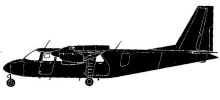
ASN Wikibase Occurrence # 320868
| Date: | Sunday 7 October 2012 |
| Time: | 16:10 |
| Type: |  Britten-Norman BN-2A-26 Islander |
| Owner/operator: | FlyMontserrat |
| Registration: | VP-MON |
| MSN: | 82 |
| Year of manufacture: | 1969 |
| Total airframe hrs: | 22064 hours |
| Cycles: | 55851 flights |
| Engine model: | Lycoming O-540-E4C5 |
| Fatalities: | Fatalities: 3 / Occupants: 4 |
| Aircraft damage: | Destroyed, written off |
| Category: | Accident |
| Location: | Antigua-V.C. Bird International Airport (ANU) -
 Antigua and Barbuda Antigua and Barbuda
|
| Phase: | Take off |
| Nature: | Passenger - Scheduled |
| Departure airport: | Antigua-V.C. Bird International Airport (ANU/TAPA) |
| Montserrat-John A. Osborne Airport (MNI/TRPG) | |
| Investigating agency: | ECCAA |
| Confidence Rating: |
A Britten-Norman BN-2A Islander passenger plane was destroyed in a takeoff accident at Antigua-V.C. Bird International Airport (ANU). The pilot and two of the three passengers were killed.
FlyMontserrat flight 107 was a scheduled service from Antigua to Montserrat. Weather conditions at the time of departure were good, although convective clouds and heavy rain showers had passed over the airport while the aircraft was parked before flight. Approximately 40 mm of rain fell at the airport during this period. There was no evidence that a water drain check was carried out on the aircraft following the rainfall.
Shortly after takeoff, the aircraft yawed and rolled to the right, descending rapidly and apparently out of control. It impacted the ground within the airport perimeter, right wingtip first and steeply banked to the right at low forward speed.
Examination of the wreckage showed the right hand engine was not producing power at the time of impact. Investigation of the fuel system showed contamination with significant quantities of water.
The right-hand fuel filler cap was of a design that was incompatible with the filler neck. Tests showed that the cap, installed in the neck, could allow water to pass into the fuel tank, for example if the aircraft were parked during periods of rain.
Causal factors:
1. Significant rainfall, and anomalies in the aircrafts fuel filler neck and cap, led to the presence of water in the right-hand fuel tank
2. Shortly after takeoff, the water in the right-hand fuel tank entered the engine fuel system causing the engine to stop running
3. Control of the aircraft was not retained after the right-hand engine stopped
The investigation identified the following contributory factors:
1. No pre-flight water drain check was carried out; such a check would have allowed the presence of water in the right-hand fuel tank to be detected and corrective action taken
2. It is possible that performance-reducing windshear, encountered during the downwind departure, contributed to a reduction in airspeed shortly before the aircraft stalled .
METAR:
20:00 UTC / 16:00 local time:
TAPA 072000Z 19012KT 6000 -TSRA FEW012CB SCT013 24/22 Q1013
Winds 190 degrees at 12 knots, Visibility: 6000 m; light rain associated with thunderstorm; Few clouds at 1200 feet AGL; Scattered clouds at 1300 feet AGL; Temperature: 24°C, Dewpoint 22°C; Pressure mb.
Accident investigation:
 |
|
Sources:
caribarena.com
Antigua Observer
Location
Images:

photo (c) Trevor Warne; Antigua-V.C. Bird International Airport (ANU/TAPA); 27 April 2012

photo (c) Werner Fischdick; Sint Maarten-Juliana Airport (SXM/TNCM); 07 April 2004
Revision history:
| Date/time | Contributor | Updates |
|---|
The Aviation Safety Network is an exclusive service provided by:


 ©2024 Flight Safety Foundation
©2024 Flight Safety Foundation